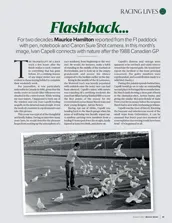March modified its F3000 car to accept a Mader-prepared Cosworth DFZ engine and went F1 racing, but although Capelli showed flair he was hindered by reliability. “Eventually Brian Hart, who was looking after the same engines for Tyrrell, tipped me the wink that there were some dodgy piston rings in circulation,” says Phillips. “We bought another engine from Frank Williams, who’d got a Cosworth just in case, and we had that one looked after by Brian, who set a new standard.”
In the meantime, the team had managed to procure the supply of a new engine for ’88. John Judd was working on an F1 adaptation of a powerplant that was derived from a Honda design. He needed permission from Honda to go ahead, and Leyton House/March got it.
Significantly, in August 1987 Adrian Newey, who was race engineering Mario Andretti’s Indycar, agreed to return to March to design the following year’s 881. “Robin Herd had very much been a mentor through my early career,” says Newey. “I had a flexible contract on the Indycar side, so come midseason ’87 I started backing off on the Indycars and picking up on F1.”
“The Leyton House 881 completely changed the design direction of F1”
A gifted aerodynamicist, Newey started designing the car around the dimensions of the small Capelli. “The cars at the time had become very uncreative animals,” continues Newey. “In the turbo era the main way to make your car go quick was give it more boost and put bigger and bigger rear wings on — they’d pretty much ignored aero efficiency. In many ways it’s one of the cars I’m still proudest of, because it completely changed the design direction of F1. Although the Tyrrell of a few years later (1990) was credited with being the first raised-nose car it was actually the March — we raised the nose underneath and tried to make it an extension of the front wing.
“We sat Ivan in the mock-up and kept moving the pedals towards him and said, ‘How far can we go for you still to be comfortable and drive the car?’ He came up with a number and we built it to that number, but when he came to drive it he was a bit squashed. It was due to our inexperience and his that it was too small.”

Capelli leads Senna on his way to second place at the 1988 Portuguese Grand Prix
Grand Prix Photo
It was even worse for Mauricio Gugelmin, signed to drive the second March. The Brazilian, while quite a small chap himself, was taller and stockier than Capelli. Mid-season changes were made to the 881, which initially suffered from low-speed mid-corner understeer. Then came that end-of-year burst. Suddenly Capelli was F1 ‘s New Star. On successive weekends in Portugal and Spain, the Italian had the affront to overtake Ayrton Senna’s McLaren. In Japan he was battling the other McLaren of Alain Prost and, briefly (lap 16, fact fans), actually led across Suzuka’s start-finish line. Prost then repassed before the March retired with ‘electrical’ problems (“Ivan switched the engine off by mistake!” grimaces Phillips).
Even so, to Phillips’s glee, March outscored the other Judd engine user, the mighty Williams, by 22 points to 20 in the constructors’ championship. “We were looking forward to 1989 with a lot of optimism,” says Capelli.















